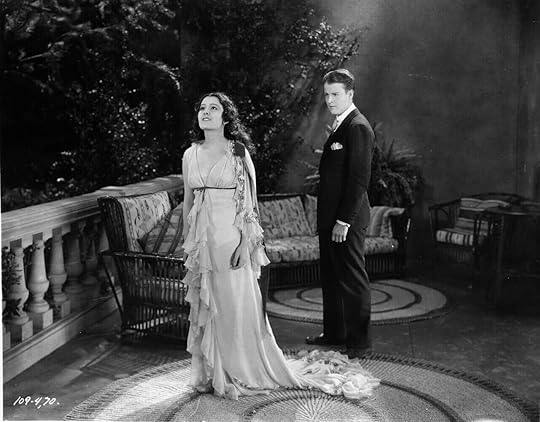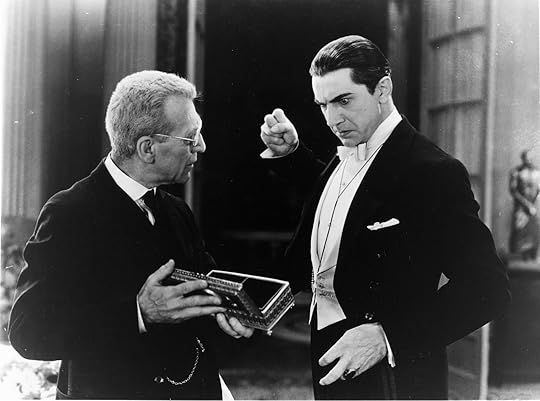Halloween Shelf: Dracula (1931) - *Alternate Spanish Language Version*
The story of how this movie was made is an interesting story in itself.

Plot: It's the Dracula story. Pretty sure you're already aware.
So, it turns out that in 1931, they didn't quite have the concept of dubbing-over movies with a foreign voice track. (Talkies were pretty new, remember; The Jazz Singer had just come out in 1927, four years earlier). In fact, they were so new to the idea of sound, that when they made the 1931 version of Dracula, they just filmed a more-or-less identical version using Spanish-speaking actors on the exact same set, but during the night when the English-speaking actors weren't using the set.
In addition to having a different cast, the film was acted slightly differently and directed slightly differently. So, in addition to being in a different language, it's like watching a completely different take on the exact same movie, story, and script.
 Oh, and the guy playing Dracula looks like a cross between
Oh, and the guy playing Dracula looks like a cross between
Bela Lugosi and Nicholas Cage.Interesting, right? There's even a debate about whether or not the Spanish-language version is better than the Bela Lugosi version -- and, with that debate in mind, we finally watched our copy.
Comparing the Two
Okay.... It's really hard for me to say whether the Bela Lugosi Dracula is better than the "Carlos Vallarias" version. Partly, because they are shot on the same set, with essentially the same script. But there are clearly different choices being made by the actors and directors.
I would probably say that Bela Lugosi is more eerie and sinister -- and Carlos Vallarias is more creepy and threatening. Bela Lugosi is more otherworldly -- while you wouldn't be all that surprised to find Carlos Vallarias peering in your bathroom window while you conduct your morning toiletries.
 With this expression on his face.Bela comes across as spooky, while Carlos comes across as disturbingly crazy. Both are frightening, but frightening in different ways. So does that make the Bela Lugosi version better, or vice versa? I don't know! It's rather hard to say. Kind of an apples-to-oranges type situation. If anything, I would say (in spite of the wacky facial expressions in this version) that the Spanish-language version is a little more subtle, and a little slower-paced. So, whether or not you would like this version or not really depends on what mood you're in (and, of course, whether you enjoy reading subtitles and/or have a good grasp of the Spanish language).
With this expression on his face.Bela comes across as spooky, while Carlos comes across as disturbingly crazy. Both are frightening, but frightening in different ways. So does that make the Bela Lugosi version better, or vice versa? I don't know! It's rather hard to say. Kind of an apples-to-oranges type situation. If anything, I would say (in spite of the wacky facial expressions in this version) that the Spanish-language version is a little more subtle, and a little slower-paced. So, whether or not you would like this version or not really depends on what mood you're in (and, of course, whether you enjoy reading subtitles and/or have a good grasp of the Spanish language).
As far as the supporting cast... I definitely preferred the English-language Renfield to the Spanish one. The Spanish one was more subdued, and Renfield is a character who just doesn't need to be subdued. I also preferred the English-language Van Helsing: the Spanish language one just didn't come across as quite as strong a character. (And looked a bit much like Eugene Levy).
 Not that Eugene Levy wouldn't make a good Van Helsing...As for the leading ladies.... I might have liked the Spanish-language leading ladies just a little better. I think they came across as less stagey and more natural, which works in this story. And they had nicer costumes!
Not that Eugene Levy wouldn't make a good Van Helsing...As for the leading ladies.... I might have liked the Spanish-language leading ladies just a little better. I think they came across as less stagey and more natural, which works in this story. And they had nicer costumes!

One thing I can say: my favorite scene in the English language version (when they attempt to get Dracula to look in a mirror in a cigar box and he flips out) is just as effective in the Spanish-language version. Different, (possibly... less surprising... but more violent?), but just as effective.

 Draculas don't like mirrors!Ultimately...
Draculas don't like mirrors!Ultimately...
I don't want to come off as demeaning when I call this film an "oddity" -- but that really is a good term to describe it. Oddity. You might argue that the alternate, Spanish-language version of Dracula is worth watching mainly from a film buff's perspective: I can't think of any other classic horror films that had a duplicate filmed in a different language, with different actors and director, but on the exact same set. A non-film buff might find comparing the two semi-identical films a tad on the tedious side.
To a film buff, however, it's fascinating. That said, while many parts of it are very fun, but I'm not sure I would watch it just for fun, on its own; I would ultimately prefer the English-language version. I do recommend that you see it, though -- and I would hope that you have already seen the English-language 1931 Dracula when you watch it. If not, please watch that soon afterwards for comparison's sake, and tell me how it compares when this is your first frame of reference. There's a chance it makes the English-language version look somewhat stilted and stagey by comparison (but, with a story like Dracula, that kind of works?) It's a tough call, so, in the end I'm going to say it's....
RECOMMENDED(With Minor "Film Buff Only" Reservations)

Plot: It's the Dracula story. Pretty sure you're already aware.
So, it turns out that in 1931, they didn't quite have the concept of dubbing-over movies with a foreign voice track. (Talkies were pretty new, remember; The Jazz Singer had just come out in 1927, four years earlier). In fact, they were so new to the idea of sound, that when they made the 1931 version of Dracula, they just filmed a more-or-less identical version using Spanish-speaking actors on the exact same set, but during the night when the English-speaking actors weren't using the set.
In addition to having a different cast, the film was acted slightly differently and directed slightly differently. So, in addition to being in a different language, it's like watching a completely different take on the exact same movie, story, and script.
 Oh, and the guy playing Dracula looks like a cross between
Oh, and the guy playing Dracula looks like a cross betweenBela Lugosi and Nicholas Cage.Interesting, right? There's even a debate about whether or not the Spanish-language version is better than the Bela Lugosi version -- and, with that debate in mind, we finally watched our copy.
Comparing the Two
Okay.... It's really hard for me to say whether the Bela Lugosi Dracula is better than the "Carlos Vallarias" version. Partly, because they are shot on the same set, with essentially the same script. But there are clearly different choices being made by the actors and directors.
I would probably say that Bela Lugosi is more eerie and sinister -- and Carlos Vallarias is more creepy and threatening. Bela Lugosi is more otherworldly -- while you wouldn't be all that surprised to find Carlos Vallarias peering in your bathroom window while you conduct your morning toiletries.
 With this expression on his face.Bela comes across as spooky, while Carlos comes across as disturbingly crazy. Both are frightening, but frightening in different ways. So does that make the Bela Lugosi version better, or vice versa? I don't know! It's rather hard to say. Kind of an apples-to-oranges type situation. If anything, I would say (in spite of the wacky facial expressions in this version) that the Spanish-language version is a little more subtle, and a little slower-paced. So, whether or not you would like this version or not really depends on what mood you're in (and, of course, whether you enjoy reading subtitles and/or have a good grasp of the Spanish language).
With this expression on his face.Bela comes across as spooky, while Carlos comes across as disturbingly crazy. Both are frightening, but frightening in different ways. So does that make the Bela Lugosi version better, or vice versa? I don't know! It's rather hard to say. Kind of an apples-to-oranges type situation. If anything, I would say (in spite of the wacky facial expressions in this version) that the Spanish-language version is a little more subtle, and a little slower-paced. So, whether or not you would like this version or not really depends on what mood you're in (and, of course, whether you enjoy reading subtitles and/or have a good grasp of the Spanish language).As far as the supporting cast... I definitely preferred the English-language Renfield to the Spanish one. The Spanish one was more subdued, and Renfield is a character who just doesn't need to be subdued. I also preferred the English-language Van Helsing: the Spanish language one just didn't come across as quite as strong a character. (And looked a bit much like Eugene Levy).
 Not that Eugene Levy wouldn't make a good Van Helsing...As for the leading ladies.... I might have liked the Spanish-language leading ladies just a little better. I think they came across as less stagey and more natural, which works in this story. And they had nicer costumes!
Not that Eugene Levy wouldn't make a good Van Helsing...As for the leading ladies.... I might have liked the Spanish-language leading ladies just a little better. I think they came across as less stagey and more natural, which works in this story. And they had nicer costumes!
One thing I can say: my favorite scene in the English language version (when they attempt to get Dracula to look in a mirror in a cigar box and he flips out) is just as effective in the Spanish-language version. Different, (possibly... less surprising... but more violent?), but just as effective.

 Draculas don't like mirrors!Ultimately...
Draculas don't like mirrors!Ultimately...I don't want to come off as demeaning when I call this film an "oddity" -- but that really is a good term to describe it. Oddity. You might argue that the alternate, Spanish-language version of Dracula is worth watching mainly from a film buff's perspective: I can't think of any other classic horror films that had a duplicate filmed in a different language, with different actors and director, but on the exact same set. A non-film buff might find comparing the two semi-identical films a tad on the tedious side.
To a film buff, however, it's fascinating. That said, while many parts of it are very fun, but I'm not sure I would watch it just for fun, on its own; I would ultimately prefer the English-language version. I do recommend that you see it, though -- and I would hope that you have already seen the English-language 1931 Dracula when you watch it. If not, please watch that soon afterwards for comparison's sake, and tell me how it compares when this is your first frame of reference. There's a chance it makes the English-language version look somewhat stilted and stagey by comparison (but, with a story like Dracula, that kind of works?) It's a tough call, so, in the end I'm going to say it's....
RECOMMENDED(With Minor "Film Buff Only" Reservations)
Published on October 17, 2017 22:30
No comments have been added yet.



